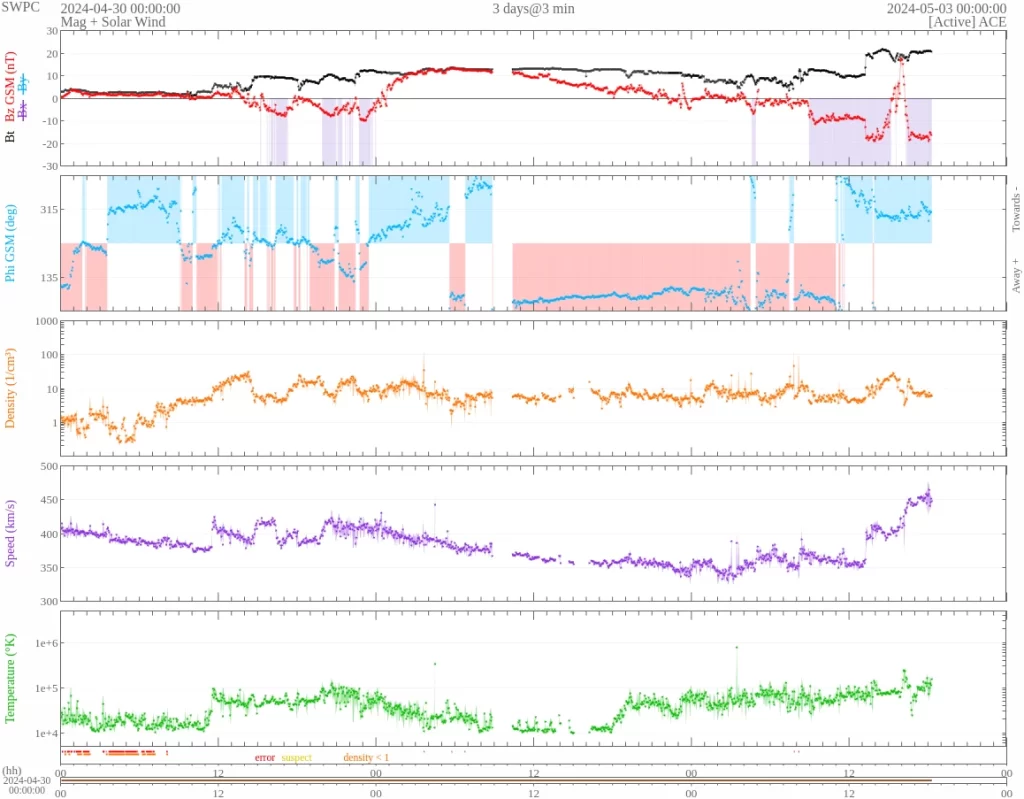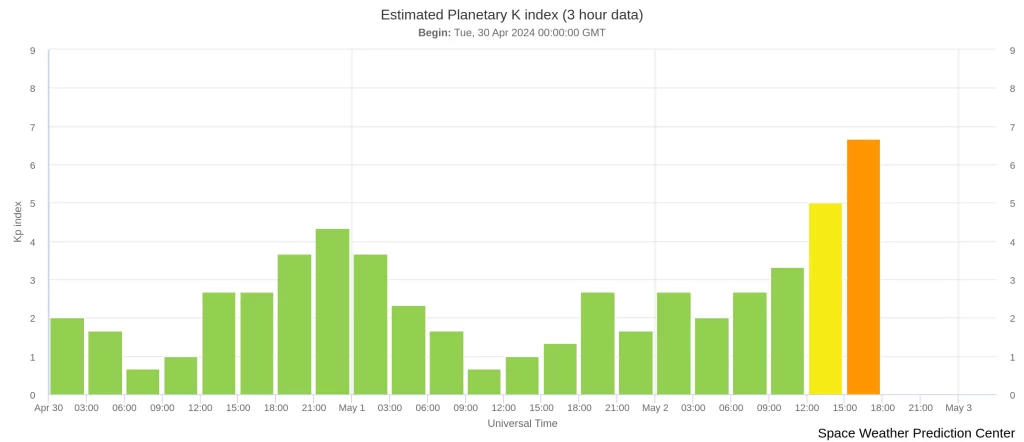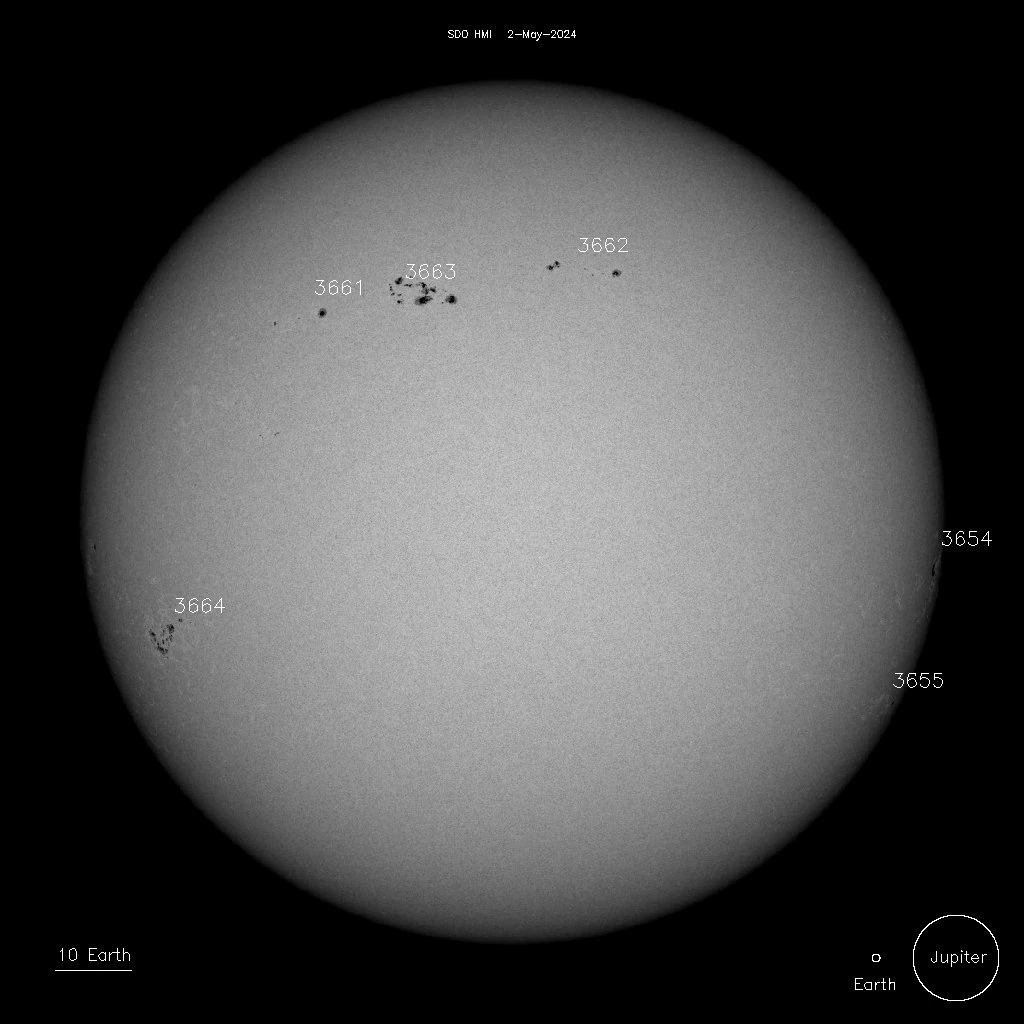Two stealth coronal mass ejections (CMEs) impacted Earth over the past 24 hours, sparking G1 – Minor to G3 – Strong geomagnetic storming. A G3 – Strong (or greater) Geomagnetic Storm Warning remains in effect through 21:00 UTC on May 2, 2024.
Over the past 24 hours, Earth has been impacted by two stealth CMEs, resulting in G1 – Minor to G3 – Strong geomagnetic storming.
The initial solar storm, although weak, was followed by a significantly stronger second storm, which has heightened concerns about potential sustained G2-level geomagnetic conditions.
According to Dr. Tamitha Skov, a noted space weather physicist, these CMEs were not predicted by many forecasting agencies, highlighting ongoing challenges in detecting such stealth events in space weather science.
“The first storm that hit yesterday [May 1], was not particularly impactful,” Skov said. But that changed when the second stealth CME hit around 14:00 UTC on May 2.

“This one is much stronger,” Skov said.
“It was an unimpressive event in coronagraphs, with no clear Earthward-directed signature. However, it has a strong magnetic field, that is pointing southward, and is fast. This second one has given us G3-levels momentarily but could keep us at sustained G2-level conditions soon. This means aurora to mid-latitudes is possible!”
Region 3654 sure has been a point of contention this week. Despite a lot of big flares, the eruptions that have occurred have been rather unspectacular– or so we all thought. Twice now, we have had stealthy #solarstorms hit Earth. (See the disk imagery, the arrows point to the… pic.twitter.com/FJ9zsUuvtO
— Dr. Tamitha Skov (@TamithaSkov) May 2, 2024
Geomagnetic K-index of 7 (G3 – Strong geomagnetic storm) threshold was reached at 17:59 UTC on May 2.
Potential impacts:
The area of impact is primarily poleward of 50 degrees Geomagnetic Latitude.
Induced currents – Power system voltage irregularities are possible, false alarms may be triggered on some protection devices.
Spacecraft – Systems may experience surface charging; increased drag on low Earth-orbit satellites and orientation problems may occur.
Navigation – Intermittent satellite navigation (GPS) problems, including loss-of-lock and increased range error may occur.
Radio – HF (high frequency) radio may be intermittent.
Aurora – Aurora may be seen as low as Pennsylvania to Iowa to Oregon.


These CMEs originated from Active Region 3654, which has been particularly active. This region, along with Region 3663, contributed to the moderate solar activity observed over the past 36 hours, including multiple M-class flares and numerous C-class flares.
Additionally, space weather forecasters at the Space Weather Prediction Center (SWPC) noted the potential for further disturbances due to nearby CMEs and isolated coronal hole high-speed stream (CH HSS). These factors are expected to maintain a disturbed and enhanced geomagnetic field in the near term.
The forecast includes a possibility of a flanking edge shock arriving at Earth by May 4, 2024, associated with a long-duration C5 flare. However, the exact impacts of this CME are still under review, with mixed results from current models contributing to the uncertainty of the forecasts.


Moderate solar activity is expected to continue from May 2 – 4, 2024, with a likely occurrence of M-class flares (30 – 55%) and a slight chance of an X-class flare (5 – 10%), the strongest category, due to the complex magnetic configurations of regions 3663 and 3654.
The electron flux, a measure of the intensity of solar radiation, is anticipated to remain at normal to moderate levels during this period.
To follow space weather in near real-time, visit SWX.
References:
1 Two Stealthy Solar Storms Hit – Dr. Tamitha Skov on X- May 2, 2024
2 Forecast Discussion Issued – 2024 May 02 1230 UTC – Prepared by the U.S. Dept. of Commerce, NOAA, Space Weather Prediction Center
Featured image credit: NASA SDO/AIA 304, The Watchers. Acquired at 10:12 UTC on April 29, 2024
Rare quadruple solar flare event on April 23, 2024
Wednesday, April 24, 2024
CME impact sparks unexpected G3 – Strong geomagnetic storm, red aurora in Missouri, U.S.
Saturday, April 20, 2024
G2 – Moderate geomagnetic storm levels forecast as two more CMEs approach Earth
Wednesday, April 17, 2024
Two incoming CMEs to combine with CH HSS and produce G1 – Minor geomagnetic storming
Sunday, April 14, 2024
Long-duration M9.4 solar flare erupts from Region 3615
Sunday, March 31, 2024
Strong X1.1 solar flare erupts from AR 3615
Thursday, March 28, 2024
Strong M6.1 solar flare erupts from Region 3615
Thursday, March 28, 2024